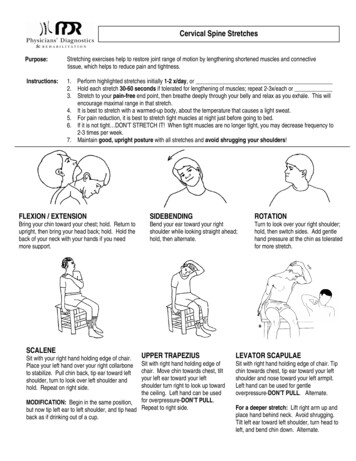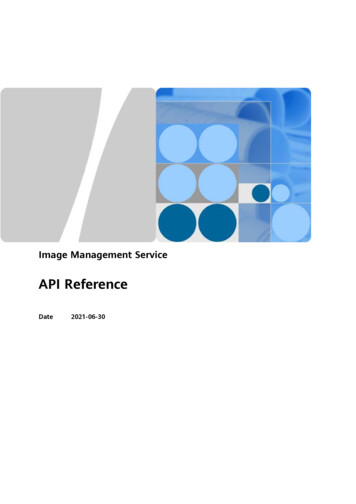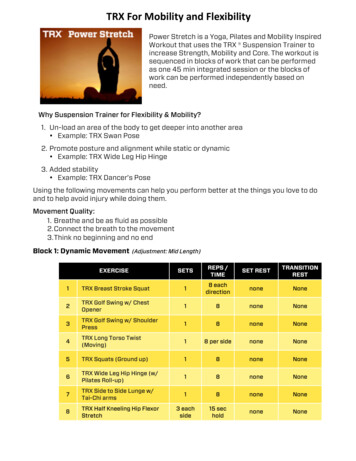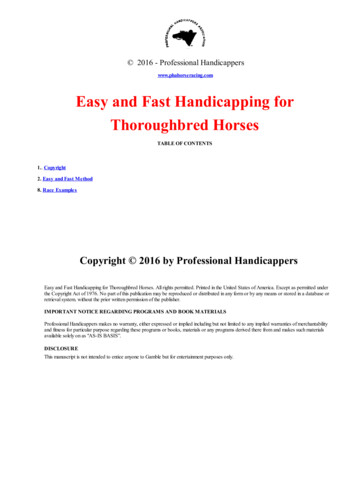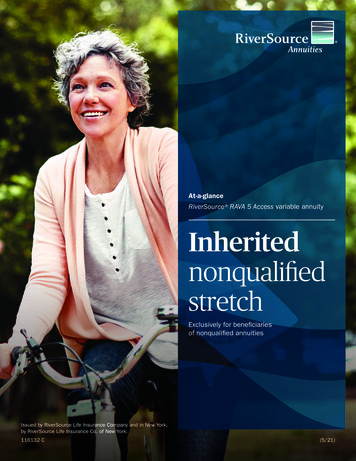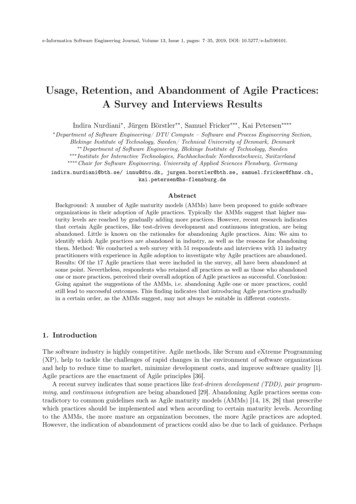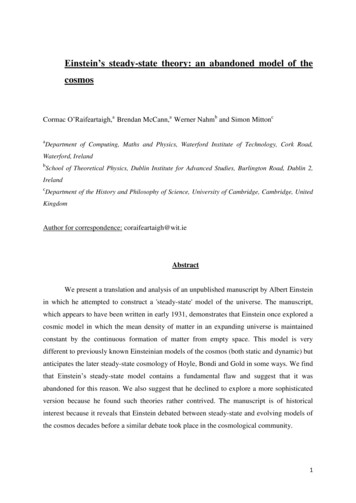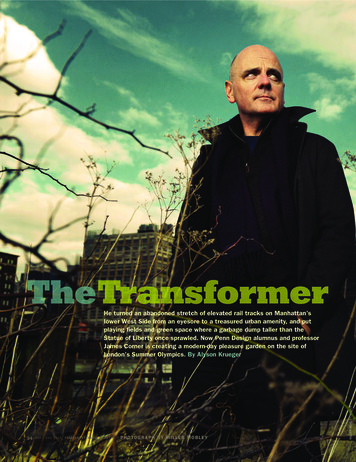
Transcription
34NOV DEC 2 01 2T H E P E N N S Y LVA N I A G A Z E T T EPH O T O G R AP H B Y MI L L E R MO B L E YMILLER MOBLEY/REDUXHe turned an abandoned stretch of elevated rail tracks on Manhattan’slower West Side from an eyesore to a treasured urban amenity, and putplaying fields and green space where a garbage dump taller than theStatue of Liberty once sprawled. Now Penn Design alumnus and professorJames Corner is creating a modern-day pleasure garden on the site ofLondon’s Summer Olympics. By Alyson Krueger
T H E P E N N S Y LVA N I A G A Z E T T ENOV DEC 2 01 235
For17 days last summer, the attention of a few billionpeople around the globe was focused on the siteof the London Olympics. There was the Grand Olympic Stadium,into which Queen Elizabeth II and James Bond appeared toparachute during the giddy opening ceremonies. In the sweeping, wave-roofed Aquatics Centre, designed by Pritzker Prizewinning architect Zaha Hadid, Michael Phelps swam his wayto gold medals 15 through 18. Huge crowds mingled withWenlock, the sort of creepy, sort of cute mascot that wore allfive Olympic rings as bracelets. The less watched but no lessinspiring Paralympic Games followed a couple of weeks later.Next, the area will go from being a stage for the world’sathletic elite to a destination where Londoners and visitorsto the city can relax and enjoy themselvesand that also, not coincidentally, promises to bring lasting development to aneighborhood that, until the Olympicscame to town, had been in decline sincethe 19th century.From the time that London put in itsinitial bid for the games, the idea was touse the Olympics to transform the LowerLea Valley, a former industrial centerlocated in London’s distant East End.Hosting the Olympics on that spot broughtresources to clean contaminated waterand soils, build transport systems thatcan get Londoners to the neighborhoodquickly and efficiently, and make the areaan enticing place for businesses andfamilies to make their home and for visitors to spend their money.But while the Olympics created the conditions for the Lower Lea Valley to get asecond wind, the site as it stands probablywouldn’t be enough to lure visitors formore than two or three years. To createsomething that would be of permanentinterest to Londoners, the organizers’answer was to build a modern-day pleasure garden—a park with organized entertainment such asconcerts and food festivals and sporting events—that, it washoped, would inspire people to flock to the area.To design the public spaces in the 50-acre London OlympicPark South, where the Stadium and Aquatics Centre—as wellas the ArcelorMittal Orbit, the 377-foot-tall, twisty, red-steelsculpture-cum-observation tower built for the Olympics—arelocated, the London Legacy Development Corporation turnedto James Corner Field Operations (JCFO), headed by JamesCorner GFA’86 GLA’86, chair of Penn’s landscape architectureprogram. The firm was selected from among more than 100bidders for the project.Corner has a long history of creating parks in unlikely places.He is best known for the design of the High Line, an elevated parkwith food service, water fountains, wooden chairs for sun bathing,and other amenities built on a stretch of abandoned elevated railtracks in Lower Manhattan. In Staten Island, he crafted themaster plan for transforming the massive Fresh Kills landfill—where garbage was piled 80 feet taller than the Statue of Liberty—into the 2,200-acre Fresh Kills Park. In Memphis, he fashioneda buffalo reserve and venue for sailing, horseback riding, andjogging out of a dark and eerie penal farm.“For many other people, they just can’t imagine anythingany different,” says Corner. “As a designer you have to be anincredible optimist and visionary and be able to see what [aplace] can be, rather than what it is.”Like a foster parent for neighborhoods, Corner takes areaswith troubled pasts and turns them into places that are “promiscuous,” “indeterminant,” “open,” “theatrical,” “dramatic,”“edgy,” “playful,” and “fun,” to cite some of the words he usesto describe his projects. Doing so, he argues, can make a citybetter—often significantly better.“Part of the real fun of living in a city isthe spectacle of its public spaces,” heexplains. “It’s just so much fun to walk thestreets, go into the different squares andplazas and the parks.“Now, for all of that to play out, that meansthe public realm needs to be designed in avery careful way to be able to endure thisdemand and to be able to stage rich andengaging settings for people to be in.”The project in London provides his biggeststage yet, and Corner welcomes the challenge. “I don’t know if I would be happy witha more anonymous site,” he says of designing the pleasure garden, which is scheduledto open in July 2014 as Queen ElizabethOlympic Park.“As a designeryou have to bean incredibleoptimist andvisionary andbe able to seewhat [a place]can be, ratherthan what it is.”36NOV DEC 2 01 2T H E P E N N S Y LVA N I A G A Z E T T EThe benefits of city parks are much more thanaesthetic, Corner insists. “People think parksare just a pretty luxury to have, whereas infact they are actually economic centerpiecesthat can help to bring a certain sense of identity and distinction to a place. So rather thanjust being a sort of luxury that comes afterwards, parks are now being conceived of asvery special places that help to catalyze new investments,” hesays, speaking more quickly in his British accent—he grew up inthe UK before coming to Penn for graduate study—as he warmsto his favorite subject.That passion—his way of talking about parks such as NewYork’s Central Park or Hyde Park in London that actually preceded economic development around them—must have comein handy during the years Corner spent working to convincecities to use parks to revitalize their neighborhoods before itwas accepted practice to do so. “For the last 20 years, Jim hasbeen promoting a view on landscape that is more than just ascenic thing,” says Richard Kennedy, associate partner at JCFO(and a lecturer in landscape architecture at Penn Design), whois leading the design of Olympic Park for the firm.It started when Corner was an undergraduate at ManchesterMetropolitan University. “There was this thing called ‘landscapearchitecture,’ and I really didn’t know what it was, but I gotinto it”—mostly because he was good at all the necessary skills:
JAMES CORNER FIELD OPERATIONSThe design for the Olympic Park“is themed around the idea of apleasure garden,” says Corner.math, biology, and art. He went on to earn a master’s degreein the subject at Penn, along with a certificate in urban design,and joined the faculty in 1989. Since 2000, he’s been chair ofthe department of landscape architecture.“I wasn’t really practicing design at the time,” he recalls ofhis early years as a professor. “I was teaching and researchingand writing a couple of books, and that was a great timebecause some of the things that we are doing now, today, inpractice, in terms of working in these post-industrial sitesand figuring out how to theatricalize and dramatize the public realm and enrich the lives of people who live in the city—alot of these things were developed in my early years teachingat Penn, using the school as a laboratory.”But Corner’s theories did not really catch on until he put theminto practice. In retrospect, it’s a bit shocking that the HighLine—a high-profile project that has inspired numerous dreamsof urban restoration among city governments—was one of hisfirst gigs. At the time, though, he was just an ordinary landscapearchitect building an ordinary park. “Even though we wereoptimistic that people would come, we had no idea of the sortof intensity of use that it carries today,” he says.Visiting the High Line, where well-dressed couples stretchout on the wooden benches reading books while their toddlersplay tag around the bushes, and sophisticates sip wine at thewine bar located within the park, it’s difficult to understandhow controversial the project was. Just a few years earlier someNew Yorkers were demanding that the High Line be torn downbecause the abandoned tracks, originally built in the 1930s todeliver freight directly to businesses along the route, were justtoo dangerous for their children to live near. It looked like theywere going to get their wish, too—demolition was approved bythen-Mayor Rudy Giuliani—when Joshua David C’84 helpedT H E P E N N S Y LVA N I A G A Z E T T ENOV DEC 2 01 237
‘‘When a site has interesting characteristics [in] itsfeatures and its history, when there are heritageelements to build in and work into the project, it makes for amuch more interesting problem,” says Corner’s colleagueRichard Kennedy.On that scale, Queen Elizabeth Olympic Park certainly qualifies as interesting. The Lower Lea Valley has been an industrial area since the age of Henry VIII, producing—as detailedin a pamphlet put out by English Heritage, which championsUK history—everything from flour to bacon to gin, gunpowderto petrol to “Parkesine,” proclaimed the “first plastic in theworld” on a memorial plaque reproduced in the brochure andused to make “pens, knife handles, combs and buttons.” The“world’s first seagoing ironclad battle cruiser,” the HMSWarrior, was built there, as were railway engines, matches,38NOV DEC 2 01 2T H E P E N N S Y LVA N I A G A Z E T T Efurniture, and textiles. While most of the factories have longsince closed, the toxins they produced still contaminated thesoil and water until right before the Olympics. To make matters worse, during World War II the valley was bombed heavily in the Blitz. The area was already so desolate that thegovernment never did a full cleanup of the damage.As a stark indication of the area’s continuing troubles withpoverty and pollution, an article on the Olympic-site planningprocess in the June 2012 issue of AIA’s magazine, Architect, notedthat “Olympics organizers commonly point out that for everystation one takes east on the London underground, the life expectancy of the surrounding neighborhood drops by one year.”Corner calls it a “hopeless part of the city,” and Susie Barson,a senior architectural investigator with English Heritage whowrote the materials on the Lower Lea’s past, says that whenshe was visiting the area it was just sad. “Oh, there was suchwaste! The kids were so bored and kicking around.”Another big disadvantage was the area’s distance from CentralLondon. With few transport options, it was hard to leave—orvisit. Even taking a tour of the grounds a week before theOlympics began, when the grounds were opened to visitors inadvance of the Games, it was still easy to feel the area’s isolation. I met my tour guide at Bromley-by-Bow, a tube station thatI had never even passed through in the three and a half years Ilived in London because it was just too far east. There werefamilies shopping in the huge Tesco (a UK grocery store), speaking a variety of languages and with large gaggles of kids in tow,but the store seemed overwhelmed by the number of foreignvisitors asking to use the restrooms before starting their owntour, as if no one had ever visited in the past.To prepare the site for the Olympics, the city fished out 9,000grocery carts from the canals and spent years purifying andtesting the water and soil. In the unruly fields it planted babytrees, public sculptures, and Ping-Pong tables. The city convinced businesses, such as Ikea, to build outlets in the vicinity and signed contracts with developers to create residentialcenters. And it constructed a new high-speed train, appropriately named the Javelin, that linked the Olympic site to CentralLondon in a mere seven minutes. On the whole, the city allocated 75 percent of its entire funds for the Olympics to theselong-lasting “legacy” projects, as they are called.“It’s one thing to imagine that certain portions of the sitecan be turned into housing,” says Kennedy. “It’s another thingto provide water, power, transit, local amenities, that make itan attractive address.”The Lower Lea Valley before the Olympics.ENGLISH HERITAGEestablish the nonprofit Friends of the High Line in 1999 to successfully press for the High Line’s preservation and conversionto a park [“Alumni Profiles,” May June 2004].Corner’s firm was named landscape architect in 2004 andconstruction began in 2006. Two sections have opened so far,in 2009 and 2011, and work began on the final section thispast September.In the event, the park became popular so quickly that NewYork magazine wrote, two years before it even opened,“Someday, around a year from now, one of your friends is goingto say to you, ‘Let’s go to the High Line.’” And a 2004 New YorkTimes editorial hit the park’s real value on the nail: “Once, itseemed the sure way to increase property values along theHigh Line was to tear it down. Now, thanks to Friends of theHigh Line and its supporters, the sure way to increase property values in the shadow of that railway is to keep it standingand to restore it.”The High Line completely rejuvenated this area along theHudson. The Standard Hotel, an upscale hotel that has a beergarden and a rooftop night club with a hot tub under its roof,deliberately positioned its rooms to have a view of the park;numerous new residential complexes popped up; and property values around the area skyrocketed. In June 2011, justtwo years after the park opened, New York Mayor MichaelBloomberg reported that the High Line had generated 2 billion in private investment.In the wake of the High Line’s success, cities from Chicagoto Shenzhen, China, have turned to Corner’s firm to effectsimilar transitions—including, of course, London.
While Barson is pleased with the overall amount of consideration given to the area’s history, she mourns the loss of afew historically interesting Victorian printing works that weretorn down in the construction, and the displacement of thepeople and local businesses that had made the area their homewhen no one else would go close. “Café owners wrote to theOlympic organizers to say could we still carry on serving chipsand things like that,” Barson recalls. “They said, ‘No, We’regoing to have Coca-Cola and other sort of big franchises.’”Other aspects of the area’s past, however, were less movableand provided challenges to Corner and Kennedy in designingthe new park. “Things like the locks and the canals and theriver, you can’t just wipe them away,” Barson notes. “Thebridges are there as well as the new bridges. There are pumping stations there are gasholders. There are still an awfullot of industrial buildings on the site.”Also factoring into the development are the artistic andethnic populations who live very close to the park and wantto have a voice in its use. Not to mention the reality that—whilethey now have an easy way to reach the Lower Lea Valley—Londoners are still not used to traveling to this part of thecity in search of recreation.“Because we are designing this park in a sort of blown-outneighborhood context, it’s not obvious why in the early yearsanybody would come use the park,” says Corner. “So there’s aneed to make this park have a special program, and its programis themed around the idea of a pleasure garden.”In that sense, it recreates an old London tradition. In the 18thcentury, pleasure gardens in various parts of London—thoughnot in this location—entertained visitors with a sensual andexotic experience. An entry on the History Channel’s websitecaptures what it was like to enter one of these venues:Long before the invention of Disneyland, Georgian Londonersenjoyed their own type of amusement park: the pleasure garden. For a modest entry fee, people from all walks of life couldescape the noise and squalor of London’s streets for a divertingevening of al fresco entertainment, socializing, romance—oreven scandal Pleasure gardens featured every sort of attraction, from the sedate to the salacious. There were manicuredwalks and impressive fountain displays, light refreshments,classical concerts, exotic street entertainers and even fireworks. Away from the prying eyes of polite society, they wereideal places for romantic trysts. Their darker corners were alsorife with prostitution scale project and make it something fresh and new and provocative and surprising was what seduced us.”As released so far, the plans for the park call for a promenadeon one side extending the length of the site, where visitorscan stroll on a paved path shadowed by looming trees. Therenderings make this feature look like something straightout of a Victorian painting. It is easy to imagine fashionableLondoners meandering arm-in-arm with loved ones or pushingstrollers on a leisurely day out.The rest of the site is less restful, and resembles a themepark. Visitors can get lost in a tall labyrinth, cool off in a watersplash pad, and test out their skills in a climbing forest. Theycan try out different kinds of snacks in the food market,marvel over public art, or listen to music in the concert hall.While some of the activities are permanent, like the maze,there is room for temporary exhibitions and programs. A seriesof food and music festivals and educational programs hasalready been scheduled for when the park finally opens.Some remnants of the Olympics will also remain in the park.A scaled-down version of the Aquatics Center will remain, aswell as the Orbit tower, which is designed for visitors to climbup to get views of the area.Perhaps most important, while this pleasure garden will besomething fresh and new for London, it does not seek to stampout the area’s culture or past, but rather incorporate them ininteresting ways. New plants will grow out of and aroundleftover ironwork that simply can’t be moved. The promenadewill weave around the rivers and locks and canals and bridges that were built during the area’s years as a working industrial center. The food stalls will offer South Asian food andother locally popular cuisine. Great efforts are being made todraw in local artists who can make permanent and temporaryexhibitions for the site and to allocate space for use by localcommunity and children’s groups.After all, says Corner, the park is only valuable if it is usedand beloved by the people who live nearby and visitors alike.“If in five years if we go back and there are dozens or hundredsof people walking along [the] promenade, and some of them areplaying and some of them are eating and some of them are strolling and some of them are sitting and some of them are running,that will be great,” he says. “And it would be great if those peopleare comprised of local cultures as well as the visitors, and youget that mix and you get the synergism No matter how beautiful it is, if there are no people there, it’s no good.”It will be two years before it’s known how Queen ElizabethCorner and Kennedy’s park will most certainly be rated PG.But it will seek to spur the same sense of fun and excitementthat one visitor, the playwright and wit Oliver Goldsmith, felton his 1760 visit to a pleasure garden: “The illuminationsbegan before we arrived, and I must confess that, upon entering the gardens, I found every sense overpaid with more thanexpected pleasure.”The challenge of eliciting that type of emotion from suchan unpromising site was both a big challenge and a key attraction for Corner and Kennedy. “The brief of creating a contemporary pleasure garden was a really compelling problem,”says Kennedy. “To take this kind of industrial and Olympic-Olympic Park will be received, and even longer to assesswhether it has done its job in revitalizing the surroundingarea. But the fact that London is even trying to use a landscapeto transform the character of one of its neighborhoods isanother step forward for Corner and his mission to use parksto change cities.“To be able to have a project like the High Line or like London—and we have one now on the waterfront in Hong Kong—theseare just extraordinary sites,” he says. “You’re thankful that thisis the type of site you are responsible for.” Alyson Kruger C’07 is a freelance writer. She profiled Fr. James Martin W’82, inthe Mar Apr 2012 issue.T H E P E N N S Y LVA N I A G A Z E T T ENOV DEC 2 01 239
answer was to build a modern-day plea-sure garden—a park with organized entertainment such as concerts and food festivals and sporting events—that, it was hoped, would inspire people to flock to the area. To design the public spaces in the 50-acre London Olympic

